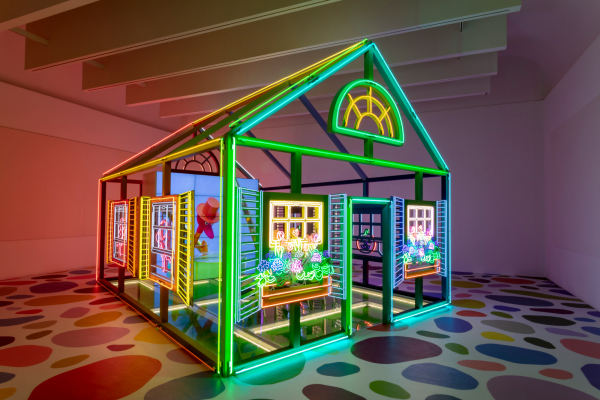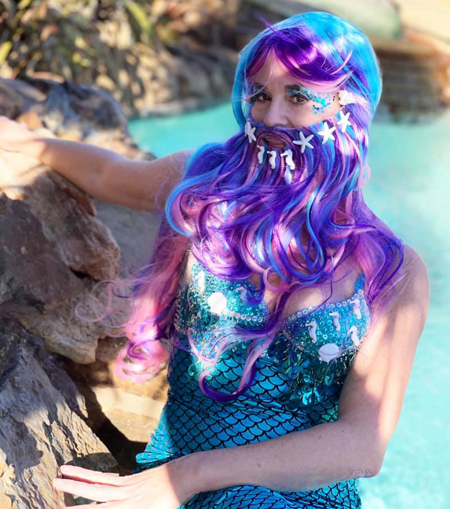The lure/allure of the Mermaid
Colette Copeland
January 2021
 Alex Da Corte, Rubber Pencil Devil, 2018, from For A Dreamer Of Houses,
Alex Da Corte, Rubber Pencil Devil, 2018, from For A Dreamer Of Houses,
The Dallas Museum of Art, Photo by Tom Little, courtesy of the artist, Karma, NY & DMA
Like many young girls, I wanted to grow up and be a mermaid. I thought having a tail and swimming in the sea would be the ultimate superpower. I remember learning about the Weeki Wachee mermaids at Weeki Wachee Springs, Florida and thinking it would be the coolest job ever. When I finally saw them perform as a young adult, I felt quite sad. The poor women had to spend all day trapped in an overly chlorinated tank, swimming with fake tails, and smiling at gawkers. I wondered how their hair and skin managed to stay in-tact.
When my daughter was growing up, she loved Disney movies. Lion King was her favorite, but the Little Mermaid held great appeal. Like most of Disney’s early heroines, the females suffered, willingly martyring themselves for the sake of a male, usually one with royal blood. Ariel was not an exception. With the encouragement of the Sea Witch, she gave up her voice for legs, then killed herself at the end. (Disney sugarcoats the ending by saying she turned into sea foam, becoming one with the sea.) The Disney heroines present confusing and damaging messages to young girls.
I recently came across Topher Payne’s work. He has revisioned alternate endings to children’s books like The Giving Tree and The Rainbow Fish. In Marcus Pfister’s original tome, the fish gives up all of his scales for the sake of others, hoping to make friends. Payne’s version presents a more empowering message–one of self-value and self-worth. What if the Little Mermaid kept her tail and her self-worth, refusing to accept true love or death as her only viable options?
 Olivia Erlanger, Pergusa, image courtesy of the author
Olivia Erlanger, Pergusa, image courtesy of the author
I was inspired to write this piece after viewing Olivia Erlanger’s sculpture Pergusa, currently part of a group exhibit at the Dallas Museum of Art. The exhibition For A Dreamer Of Houses features fifty works from the DMA’s collection, focusing on domestic objects and structures. The exhibition title and theme are inspired by philosopher Gaston Bachelard’s book The Poetics of Space.
Erlanger’s work, a recent acquisition by the DMA is displayed with two other sculptures–one by Robert Pruitt and the other by Sarah Lucas. The three contemporary surrealist sculptures utilize subversive humor to address themes of domestic gendered labor, desire and repulsion. The three works are contextualized within the exhibition sub-category of drawers, chests and wardrobe, a chapter taken from Bachelard’s book, that conjures images of sacred, secret spaces–repositories of memories and desires. Pergusa features a yellow mermaid tail sticking out of a Maytag washing machine. This work elicits emotions of dark humor and sadness. Perhaps the washing machine is a secret portal that leads to the ancient Greek lake– Pegusa, presumably home to mermaids. Lost between the two worlds of land and water, the mermaid is in limbo, an outlier searching for their place, their home.
 Rob Pruitt, me and this mic is like yin and yang, image courtesy of the author
Rob Pruitt, me and this mic is like yin and yang, image courtesy of the author
Pruitt’s and Lucas’ work also explore notions of gender and desire. Pruitt’s work entitled me and this mic is like yin and yang features an old fashioned vacuum cleaner, set on top of a large doily mat. At the top of the vacuum handle is a microphone. Contrasting the stark whiteness of the background and shiny newness of the microphone, the vacuum and doily look worn and grimy. The addition of the microphone lends a performative aspect to the sculpture, as we imagine a 1950’s housewife, who longs to pursue a singing career on stage. As a contemporary practical invention, I know I would be more motivated to vacuum if my hoover had a mic attached.
 Sarah Lucas, ICON, image courtesy of the author
Sarah Lucas, ICON, image courtesy of the author
Sarah Lucas’ sculpture ICON features an organic female form made from cotton and kapok. The form appears to be sitting on a desk chair, but upon closer examination, the upper torso is merged with the chair top. The figure is wearing tartan plaid tights and appears to be kicking one leg in the air, can-can style. Both the long leg protrusions and the flaccid arm protrusions (in place of a head) also resemble phallic forms. I interpret the body language and stance as a F..K Y.. to patriarchy. Despite the imprisonment that the chair represents, the figure refuses to comply, literally dancing in their seat.
At age 54, I finally had the chance to realize my mermaid dream, but on my own terms–dismissing the traditional archetype. My mermaid is a bad-ass with a beard. She is sexy, scholarly and comfortable in her own skin/scales. She is a proud non-conformist. She recently competed in an online beard competition, benefitting the food bank of Tarrant County.
Dallas Museum of Art
March 15 – July 4, 2021
◊
Inspired by Dada, and Situationist Theater, Colette Copeland is a multi-media visual artist whose work examines issues surrounding gender, death and contemporary culture. Sourcing personal narratives and popular media, she utilizes video, photography, performance and sculptural installation to question societal roles and the pervasive influence of media, and technology on our communal enculturation. Her videos employ experimental narrative techniques, and absurdist humor to explore the landscape of human relationships.
Over the past 26 years, Copeland’s work has been exhibited in 25 solo exhibitions and 141 group exhibitions/festivals spanning 35 countries. She received her BFA from Pratt Institute in New York and her MFA from Syracuse University. Currently she teaches art and digital media at University of Texas, and Collin Colleges in Dallas, Texas.

